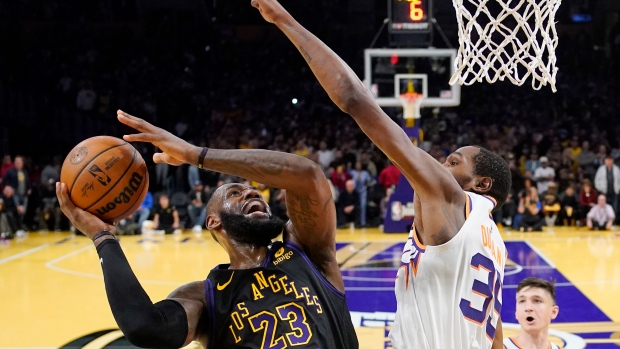Dec 6, 2023
NBA’s In-Season Tournament a slam dunk for Off-Season Negotiations

Written by: Dan Gladman
Follow: @dgontheroad
DeMar DeRozan of the Chicago Bulls might not have appreciated the Toronto Raptors running up the score in an NBA In-Season Tournament game in November, but the L.A. Lakers’ Lebron James understands the importance of the league’s colourful new event.
“We know what it’s about,” he said. “We know what’s at stake.”
For the teams and the players, there is money at stake, and that will always drive anyone, let alone professional athletes who mostly compete for the thrill of winning while their salaries are guaranteed. The fact that an extra $500,000 USD is on the line for each player on the team that wins the IST is motivation enough to provide that extra effort in regular season games that traditionally don’t promise complete focus in November.
But the truth about this outside-the-box initiative is that the stakes are so much higher than who wins, and how much prize money is doled out.
The league’s media rights deal expires after the 2024-25 season. An ever-changing landscape in how sports broadcasting is delivered and consumed provides an opportunity for the NBA to monumentally increase its take in the most profitable aspect of its revenue. The In-Season Tournament is meant to increase competition and interest early in the season, but also to provide potential broadcasters and advertisers an intriguing extra part of the schedule to, you know, spend more money on.
“Financially for the league, they’re negotiating a new media rights deal,” said ESPN’s Adrian Wojnarowski on TNT’s “Inside the NBA.”
“The In-Season Tournament is going to be a big part of that and ultimately, players, teams, they share in that revenue.”
Evan Wasch, executive vice president of basketball strategy and analytics at the NBA described the IST to Sports Business Journal as “a tentpole event comparable to All-Star, Christmas Day, play-in and the playoffs.” There has been talk about some sort of tournament in the NBA for the past 10 years. Of course, it was the upcoming negotiation for media rights that triggered the event to finally come to fruition in 2023.
Out came the new-look basketball courts, team “city edition” uniforms and players gunning extra hard for early season wins. The results were tangible and immediate.
According to SBJ, “six tournament games on ESPN averaged 1.58 million viewers. That’s up 24% from the five NBA games ESPN carried on November Fridays last year. TNT’s four Tuesday night tournament games averaged 1.32 million, up 7% from the net’s Tuesday night November average last year.”
Twenty games into the 82-game season and NBA viewership is up 12%. This is a rebound for a league that has seen declining viewership in the past 10 years, exactly the tonic for the league entering into media rights negotiations.
Huddle Up newsletter states: “The rumours are that the league is looking to get $5 billion to $8.33 billion per year, equating to a 9-year, $45 billion to $75 billion deal.” This would increase their current deal times two or three, which is currently $2.66 billion spread across Disney and Warner Bros. Discovery. But that contract doesn’t include a streaming partner.
The biggest sports entity in the world – the National Football League – recently inked a $110 billion deal with games sprinkled around different days of the week, networks and streamers. Major League Soccer is completing its first season on Apple TV, with the league reportedly earning $250 million per season from the world’s richest company. The NBA business is much closer in comparison to the NFL’s but the MLS experiment is being observed by all. The nature of the next NBA deal is certain to include aspects first debuted by other sports and leagues.
Which brings us back to the In-Season Tournament, which hits its apex with a Final Four style conclusion this week. Two semifinals will be played Thursday night in Las Vegas with the winners meeting for all the marbles Saturday night on ABC. The first winner of the NBA Cup will take home millions but the resonance will be felt at the negotiating table, where mere millions will convert into numerous billions.
By the time that deal is signed, DeMar DeRozan’s qualms with running up the score will be long forgotten, as the league, teams and players’ revenue generated from media rights enters unearthly stratospheres.